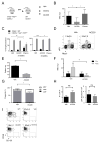Mutational cooperativity linked to combinatorial epigenetic gain of function in acute myeloid leukemia
- PMID: 25873173
- PMCID: PMC4518555
- DOI: 10.1016/j.ccell.2015.03.009
Mutational cooperativity linked to combinatorial epigenetic gain of function in acute myeloid leukemia
Abstract
Specific combinations of acute myeloid leukemia (AML) disease alleles, including FLT3 and TET2 mutations, confer distinct biologic features and adverse outcome. We generated mice with mutations in Tet2 and Flt3, which resulted in fully penetrant, lethal AML. Multipotent Tet2(-/-);Flt3(ITD) progenitors (LSK CD48(+)CD150(-)) propagate disease in secondary recipients and were refractory to standard AML chemotherapy and FLT3-targeted therapy. Flt3(ITD) mutations and Tet2 loss cooperatively remodeled DNA methylation and gene expression to an extent not seen with either mutant allele alone, including at the Gata2 locus. Re-expression of Gata2 induced differentiation in AML stem cells and attenuated leukemogenesis. TET2 and FLT3 mutations cooperatively induce AML, with a defined leukemia stem cell population characterized by site-specific changes in DNA methylation and gene expression.
Copyright © 2015 Elsevier Inc. All rights reserved.
Figures





References
Publication types
MeSH terms
Substances
Grants and funding
- R01 CA173636/CA/NCI NIH HHS/United States
- R01 CA166835/CA/NCI NIH HHS/United States
- R01 CA166429/CA/NCI NIH HHS/United States
- R01CA166835/CA/NCI NIH HHS/United States
- U10 CA021115/CA/NCI NIH HHS/United States
- U24 CA196172/CA/NCI NIH HHS/United States
- R01NS076465/NS/NINDS NIH HHS/United States
- R01HG006798/HG/NHGRI NIH HHS/United States
- P30 CA008748/CA/NCI NIH HHS/United States
- R01 HG006798/HG/NHGRI NIH HHS/United States
- R01 CA169784/CA/NCI NIH HHS/United States
- CA172636-01/CA/NCI NIH HHS/United States
- U10 CA180820/CA/NCI NIH HHS/United States
- R01 NS076465/NS/NINDS NIH HHS/United States
- P30 CA013330/CA/NCI NIH HHS/United States
- U10 CA180827/CA/NCI NIH HHS/United States
LinkOut - more resources
Full Text Sources
Other Literature Sources
Medical
Molecular Biology Databases
Research Materials
Miscellaneous

